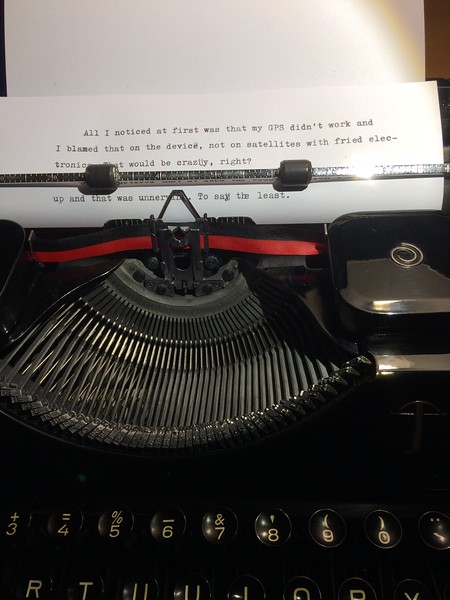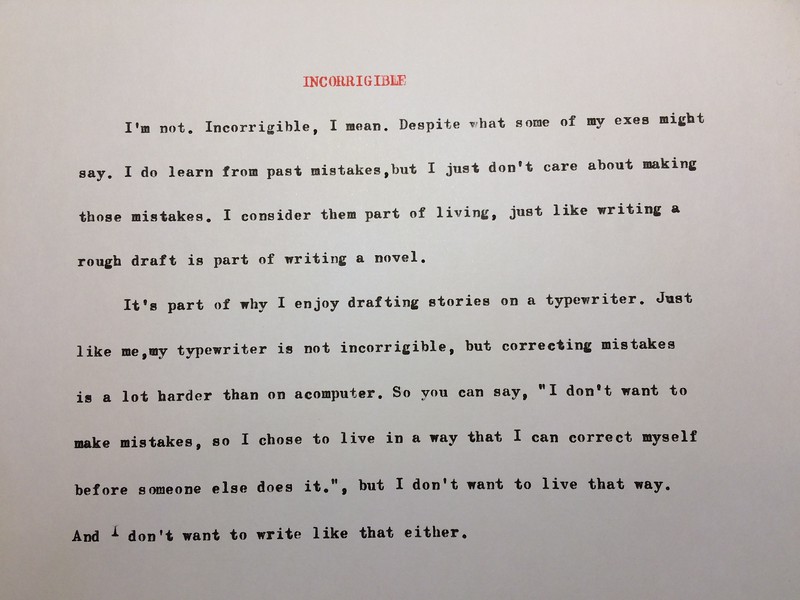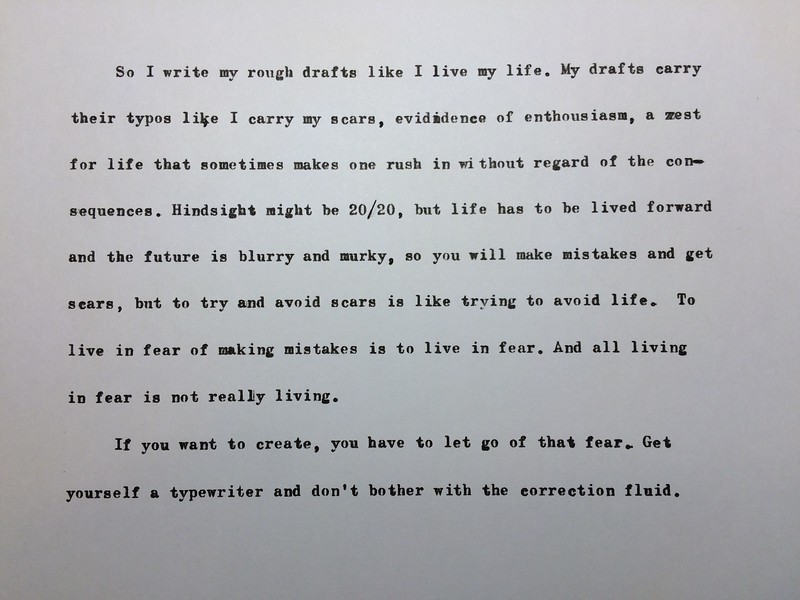Typecast essay: Incorrigible.
Posted: December 24, 2018 Filed under: opinion, Typecast, Typewriters, Writing, writing skills | Tags: draft, essay, life, novels, scars, Typecast, typewriter, Vespa, writer life 2 Comments



WRITING: “The Biggest Mistakes Writing Your First Book?”
Posted: April 19, 2016 Filed under: Publishing, Uncategorized, Writing, writing skills | Tags: biggest, draft, editing, first book, frustration, manuscript, mistake, novel, novelist 2 CommentsMy Biggest Mistake Was Writing A Book.
Although I should qualify that statement: my mistake was attempting to write a book from start to finish, in reading order, from page 1 to 500. I started with the opening chapter, I wrote every chapter in sequence, I edited it while I wrote, I bumped into obstacles that totally destroyed the pace, I kept pounding my head against the walls of the scenes that just wouldn’t come out of my mind, I got stuck in frustration on finishing an unwilling chapter before I could start on the next, and I exhausted myself before I finished.
And then I found out that the second storyline sucked and had to be removed, leaving only one side of a zipper without a corresponding side that could be zipped together into a coherent story. So I wrote another storyline that had to be inserted into the existing storyline.
The result was a lumpy, lopsided mess that brought me to despair. And since I’m an autodidact writing suspense fiction in my second language, I had no peers around.
Then I found a writing website, now sadly gone, called Thoughtcafe, where I found my peers. People who read my stuff, told me it was incredible and worthy of all the attention I could muster to polish out the lumps and make it run smoothly like the zipper was oiled with eel’s snot.
My second novel practically wrote itself. I didn’t give a shit anymore about the order in which to write, I wrote the draft for myself without any regard for punctuation, grammar, and spelling, and I kept my inner editor locked away in a dungeon until I finished the whole rough draft.
Only after I wrote the draft of the entire novel did I sit back and reread it while highlighting problem areas and adding notes on how to fix the flaws.
Which is why I always tell beginning writers: ‘Don’t Write a Book, but a Draft‘. Write the scenes in random order, assemble them in a sequence that pleases you, see what’s missing and fill that in until the story flows, then get your editor to help you iron out the wrinkles.
The first draft is ‘For Your Eyes Only, Only For You’. Not to be shown to anyone else until you turned it into a manuscript, which will be read by your betas and editor, who will provide you with feedback to improve the manuscript into something publishable.
But the writing part? That’s yours, and nobody should touch that.
WRITING: How to begin and end a chapter – my process of structuring a book.
Posted: November 14, 2015 Filed under: Amsterdam, Publishing, Writing, writing skills | Tags: about, amsterdam, antagonist, assassin, book, chapter, character, craft, draft, e-draft, ebook, edit, highlight 2 CommentsI often get question on how I write, how I know what I put in or take out, how I know when to end a chapter and begin a new one… This blog post explains how I turn the messy first draft of a book into a manuscript that is structurally sound.
WRITING: “If Only I Could Find The Time…”
Posted: October 24, 2015 Filed under: movies, opinion, Publishing, Reading, television, Writing, writing skills | Tags: chapter length, character names, draft, edting, manuscript, opening sentence, scenes Leave a commentOne of the most annoying statements people make when they hear I’m a writer, is that they’ll shake their heads and say, “I’d love to write a novel, if only I could find the time.”
To most writers, this is a seriously demeaning statement, because most of us have 24 hours in a day, juggling our work, private life, responsibilities and social activities, and yet we authors are able to find our time to write.
I’ve written several novels and short stories and I’ve had people asking me, where do you find the time to write? And I tell them, wherever I can:
- I worked night shifts as a security officer, filling the bulk of my shifts with writing.
- I rarely watch live television, but I pre-program my television to record what I want to see, so that I can fast-forward through commercial blocks (a two-hour movie on television contains some 30-40 minutes of commercials!).
- I write on an iPad with a bluetooth keyboard that I take everywhere, so I can write in waiting rooms and playgrounds (where my children are running around).
- I turn my manuscripts into e-books that I can edit on my e-reader while I’m waiting in queues at the supermarket or during rides in public transport.
- I get up an hour before the rest of the family wakes up, so I can cram in some writing before breakfast.
And I don’t mess around when I’m writing:
- I write in drafts so that I finish a draft before I start editing. Writing and editing require different mindsets – I used to edit while I wrote, but I don’t do that anymore, because my inner editor will stifle my creative mind. And if you spend time editing on a scene that you’ll cut anyone is wasted time.
- I don’t worry about beginnings, endings, chapter length, opening sentences, character names, or if the right words don’t come to mind (I write the closest word and add a @, so I can find the word again when I’m editing). Most of that stuff will be decided on in the editing process. My first rough draft is not to be read by anyone but myself.
- Formatting, like smart quotes, bold, italics, chapter names, et cetera, is decided in the late editing stage, when the story is shaping into a manuscript.
The most important thing is that rough draft. Get that story out of your mind and onto a paper or screen, so you can look at what was in your head. Two hours movies often have several hours of deleted scenes that never made the movie. A sixty minute album of music will require a week of studio time. A novel you can read in eight hours was created in twelve months from a manuscript that might take twenty-four hours to read.
When you get better at filming, you will become more efficient. You won’t need to shoot eight hours of film to produce a two-hour movie. You won’t need weeks to produce sixty minutes of music. And you won’t need to re-write your draft six times to produce a polished manuscript. With practice, you become more efficient.
Don’t fritter your time away – do something constructive and write that draft. You can thank me later.
WRITING: I Want To Write A Novel, But Where Do I Start?
Posted: September 23, 2015 Filed under: Amsterdam, opinion, popular, Publishing, Reading, Series, Writing, writing skills | Tags: draft, engage, horror, manuscript, novel, novella, reader, start Leave a commentHaving a passion for something, but no skills yet and several hindrances to acquire those skills makes for quite a challenge.
The easiest answer would be ‘find something else’, and there would be truth in it. Writing a novel (or even a short story) is an appealing ambition – I read somewhere that eighty percent of all adult Americans seriously entertain the notion of writing a novel, which is also why there’s a whole industry that facilitates burgeoning writers with creative writing courses and workshops and seminars, and enough books on the art & craft to fill several bookcases.
The reason writing a novel is so popular is because it’s an attainable goal (most arts require more than a pen and a piece of paper) and it carries prestige as good writers are revered, their works read both during and after their lifetime.
So what you have to decide for yourself is – do you really want to write a novel, or do you want to show people a shiny cover with your name on it and bask in the adulation? Because the first is hard, and the second is a pipe dream.
I’ve written five novels (published four) and four novellas, just as frame of reference to my answer – if you don’t want to let go of your dream, this is my advice:
Lower the pressure of writing a novel by not writing a novel.
What you will be writing instead, will be a Draft. A Rough Draft. An unreadable shitload of words, not intended to be read by anyone but yourself. That last part is extremely important! Nobody must read that Draft, because it’s not intended for public consumption yet.
The Draft is the Baby, the Novel is the Adult.
People don’t make adults, they make babies that shit and cry and demand food and attention and will keep you up at night. Have you heard writers referring to their novel as a baby? Yes? They’re not actual writers yet, because the draft is the baby, the novel should be an adult, capable of standing on its own legs and fending for itself. If their novel is still their baby, then they haven’t finished yet and they have published prematurely.
The Horror, the Horror…
Before a novel can stand on its own legs, it needs to be born first, which is a messy process. Thus, the Draft is a baby – a stinking smelly mess that will hijack all your attention and cause you to lay awake at night, worrying if it will ever be able to be independent. This is not the kind of baby that you show your family and friends – starting the Draft is not an accomplishment. So shut up about ‘writing your first novel’ and never ever talk about the plot and the characters and the theme. Screw all that. Talking about your creative work kills the spark. Just write and write. Is it garbage? Don’t second-guess yourself, you won’t be able to judge it now, you’re much too close. Nobody throws out their baby, no matter how much it smells. Just keep on writing. Don’t edit. You can’t edit a baby, it has to become an adolescent first.
The Need.
Visit any writing forum and you’ll see the many many questions, that boil down to one single question ‘Is This Any Good?’. It’s the fear of failure, the angst of wasting time, and the need for validation. We have been programmed to desire approval – from parents, from teachers. You won’t get approval for the Draft. Don’t ask for it. Just write it all down.
The Rules.
‘How long is a chapter supposed to be?’, ‘How do I write a dynamite first chapter?’, ‘Should I use present tense or past tense?’, ‘Is writing in First Person easier than Third Person?’, ‘When do I Show, when do I Tell?’
If you visit writing forums, you’ll hear a lot of talk about rules, but those rules are not for drafts. Those rules are to clinically dissect a finished manuscript prior to publication. Do you have that? No, you haven’t. You have a smelly mess that isn’t nowhere near finished, so forget about all those rules. Because in the end there is only one rule – Engage The Reader. And your baby won’t need to engage the reader yet. It’s a draft, intended only for your eyes.
The Work
Anyone with a knife and a dead pig can butcher a pig, but that doesn’t make you a butcher. And it sure as hell doesn’t make you a veterinarian.
So you wrote an essay at school and the teacher gave you an A. Does that make a writer? No, but it’s a start. If you can read this, you can probably write. You can string words together, maybe in some pleasing way, but five hundred pages of words is not a book. A book is when the words disappear and your imagination shows you the film in your head. That’s the hardest part, and the most neglected part – writers want to write pretty words or show off their ostentatious vocabulary, but what you want to do is tell a story. Tell a story in such a way that the reader forgets about the book or the e-reader and is transported to another world – fictional, but just as ‘real’ as this one. And that requires not only a large vocabulary, but also a decisive mind to apply just the right word. And if you get that right, you won’t need the validation anymore, because there is no better feeling that getting a sentence just right, a paragraph that leaps off the page, and a chapter that you don’t want to end.
But before you get there, you have to put in the work. There’s a common ‘rule’ floating around that to become a professional at something requires putting in something like 10,000 hours. I never measured that, but I do know that I’d been writing for twenty years before Reprobate was published. And I’d been working on Reprobate and all its predecessors for most of that time. Learning the craft, honing my skills. Draft upon draft upon draft. For Reprobate, it was something like forty (!) drafts. Literally every paragraph was rewritten at least once. Edited and polished. That’s the education.
Don’t Do The Crime If You Can’t Do The Time.
My second novel, Peccadillo, was half finished when Reprobate came out. I finished Peccadillo in three months, spending a total of fifteen months on writing it. I wrote the novella Locked Room in three weeks. Microchip Murder took me less than two. And the novella that gets the highest praise, Fundamental Error, was written in eight days. Rogue, the third novel took less than 12 months. And Ghosting, the novel I’m working on now, clocks in at about eight months, despite my battles with kidney stones and glaucoma.
Every time you write, you will get better at telling the story. Writing this answer took me about an hour, with no rewrites or polishing necessary. And that’s because I’ve done the time.
So do the time. Stop fretting about whether you have something to say or who will read it. Write that draft first, the rest comes later. Let me know when you finished a draft, and then we’ll talk about how you can become a writer…
